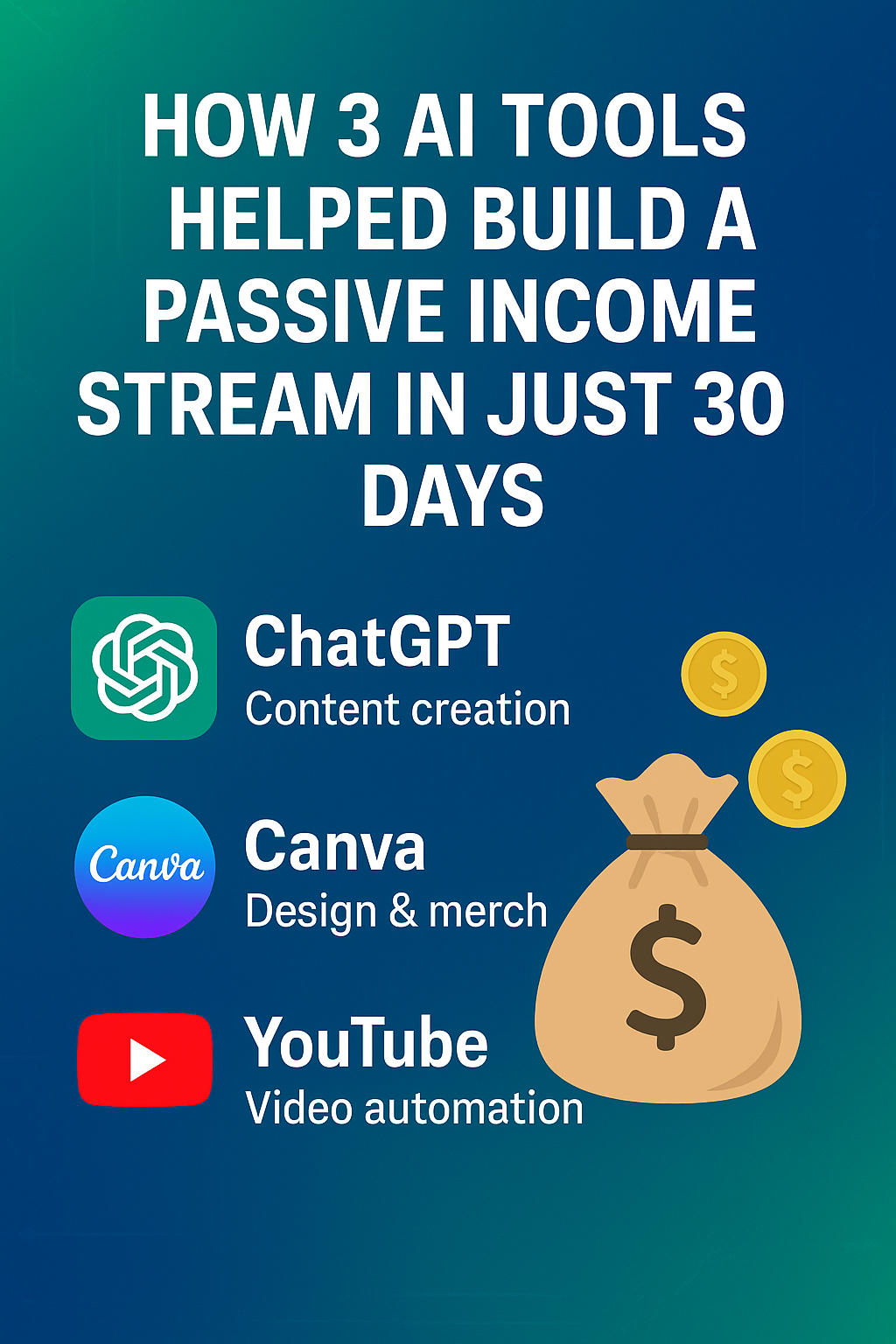How 3 AI Tools Helped Build a Passive Income Stream in Just 30 Days

Introduction
For years, the idea of making money while you sleep sounded like a fantasy reserved for the wealthy. But thanks to Artificial Intelligence (AI), this dream has become more realistic than ever. AI doesn’t literally “print money,” but it can automate tasks, create content, and run systems that continue working even when you’re offline.
In this article, we’ll walk through a 30-day case study where 3 AI tools were used to test how much passive income can be generated in just one month. This is not a “get-rich-quick” scheme. Instead, it’s a practical, step-by-step approach anyone can replicate with time, patience, and the right mindset.
By the end, you’ll see what worked, what didn’t, and what lessons you can apply if you’re serious about building AI-powered income streams.
Step 1: Content Creation with ChatGPT
Why Content Matters
Content is the backbone of online income. Blog posts, ebooks, and social media updates all have the power to attract attention, drive traffic, and generate revenue through ads or affiliate links.
But writing consistently is hard. This is where ChatGPT comes in.
How It Was Used
Brainstormed blog post ideas around “AI for beginners,” “online side hustles,” and “digital tools for students.”
Drafted full articles in minutes, then lightly edited them for tone and accuracy.
Repurposed content into ebooks and guides that could be sold or offered as free downloads to grow an email list.
Results After 30 Days
10 blog posts were published using ChatGPT as a writing assistant.
Site traffic grew steadily as content was shared on social media.
Google AdSense approval came through in week 3, starting to generate small daily earnings.
Affiliate links embedded in posts started receiving clicks, though only a few converted into sales.
Key Takeaway
ChatGPT doesn’t replace your voice, but it makes writing faster and easier. The more quality content you publish, the higher your chance of long-term passive income through ads and affiliate marketing.
Step 2: Design & Merch with Canva AI and MidJourney
Why Digital Products?
Unlike physical goods, digital products like T-shirts, posters, and mugs don’t require upfront stock or delivery. Using print-on-demand (POD) platforms, you can upload a design once, and every time a customer orders, the platform prints and ships it — while you sleep.
How It Was Used
Canva AI was used to generate simple text-based designs with stylish fonts and templates.
MidJourney created unique artwork (abstract images, futuristic landscapes, and AI-themed designs).
Designs were uploaded to platforms like Redbubble, Teespring, and Merch by Amazon.
Results After 30 Days
20 designs were uploaded across 3 platforms.
Redbubble store received 250+ visits from organic search.
3 sales were made (a T-shirt, a mug, and a sticker).
Profit was small — less than $30 total — but remember, the designs remain online forever, meaning sales can continue long after the initial 30 days.
Key Takeaway
POD is slow to start, but it compounds over time. The real value is in creating evergreen designs that can sell for years without extra effort. AI tools make it easy even for non-designers to start.
Step 3: Video Automation with Pictory and Synthesia
Why Video?
YouTube is one of the best platforms for passive income. Once a video is published, it can generate views — and ad revenue — for months or even years. The challenge? Creating consistent, engaging videos without spending hours recording and editing.
How It Was Used
Pictory converted blog posts into short, engaging videos with stock footage and captions.
Synthesia generated AI avatars delivering scripted content, making it possible to run a faceless YouTube channel.
A publishing schedule of 2 videos per week was followed.
Results After 30 Days
8 videos were uploaded to a new YouTube channel.
The channel gained 120 subscribers and over 4,000 total views.
No ad revenue yet (because YouTube requires 1,000 subscribers + 4,000 watch hours), but growth was consistent.
TikTok and Instagram reels repurposed from the same content attracted additional followers.
Key Takeaway
Video is a long-term game. It rarely pays off in the first month, but consistent posting combined with AI automation creates assets that can generate revenue down the line.
Lessons Learned in 30 Days
- AI is a Partner, Not a Magic Button
AI speeds up the process, but you still need strategy, creativity, and consistency. - Start Small and Scale
Testing too many platforms at once spreads you thin. Focusing on just 2–3 tools is more effective. - Patience is Key
Real passive income takes time to grow. The first 30 days are about laying foundations, not massive profits. - Diversify Your Streams
Blogs, POD stores, and YouTube channels work together. If one grows slowly, another may pick up faster.
Final Results After 30 Days
Blog + AdSense earnings: $20
Print-on-demand sales: $30
YouTube growth: 120 subscribers, 4,000 views (no earnings yet)
Total: Around $50 in passive income potential.
It’s not life-changing, but here’s the beauty:
The blog posts remain online and continue earning.
The merch designs can sell for years.
The YouTube channel has momentum and could become monetized in a few months.
Conclusion
This 30-day experiment proved one thing: AI tools don’t make you rich overnight — but they make building passive income streams easier, faster, and more accessible than ever before.
The combination of content creation, digital product design, and video automation created a foundation that will continue to grow long after the initial work was done.
If you’re serious about making money with AI, the best advice is simple:
Pick one income stream to start with.
Use AI tools to automate as much as possible.
Stay consistent for at least 3–6 months.
The first $50 is proof of concept. The next $500 or $5,000 comes from scaling what already works.